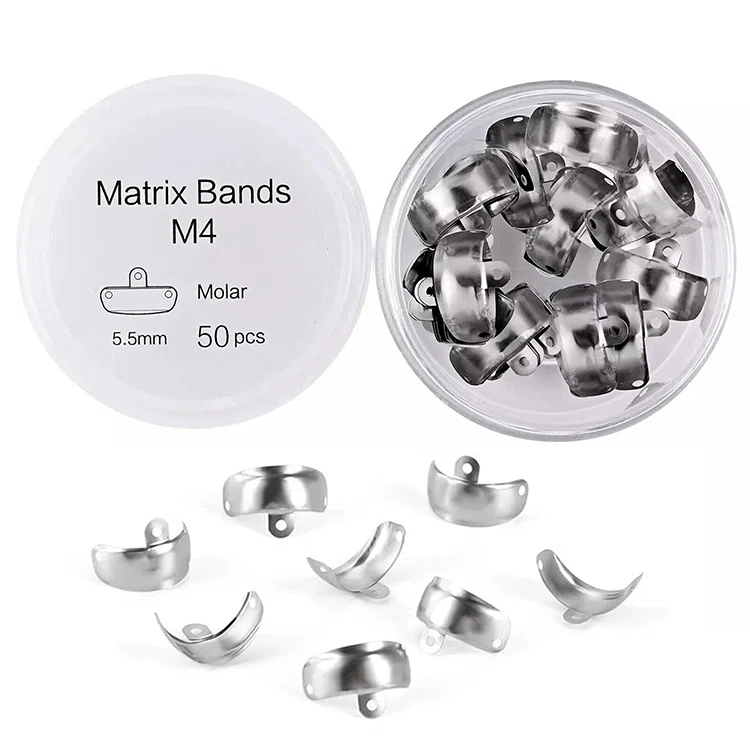
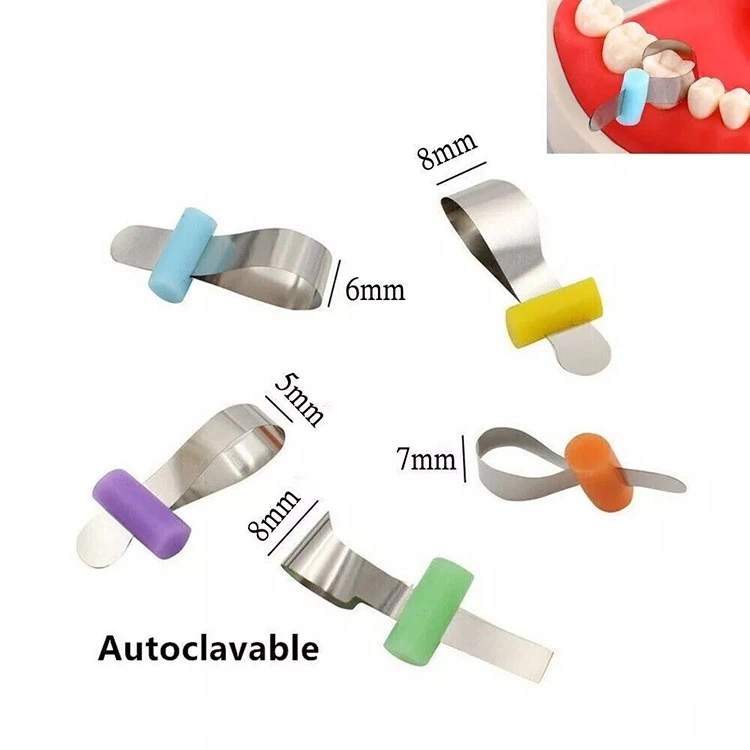
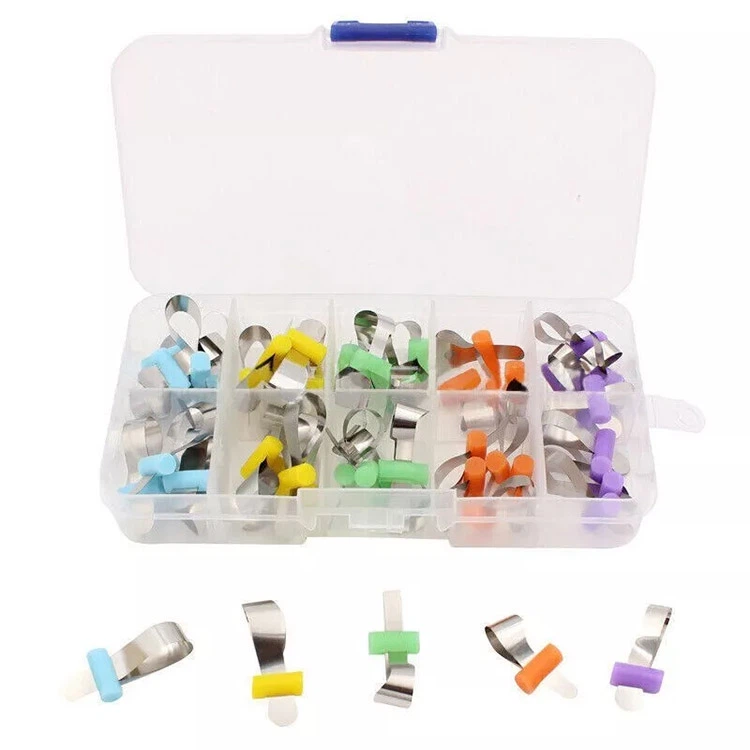
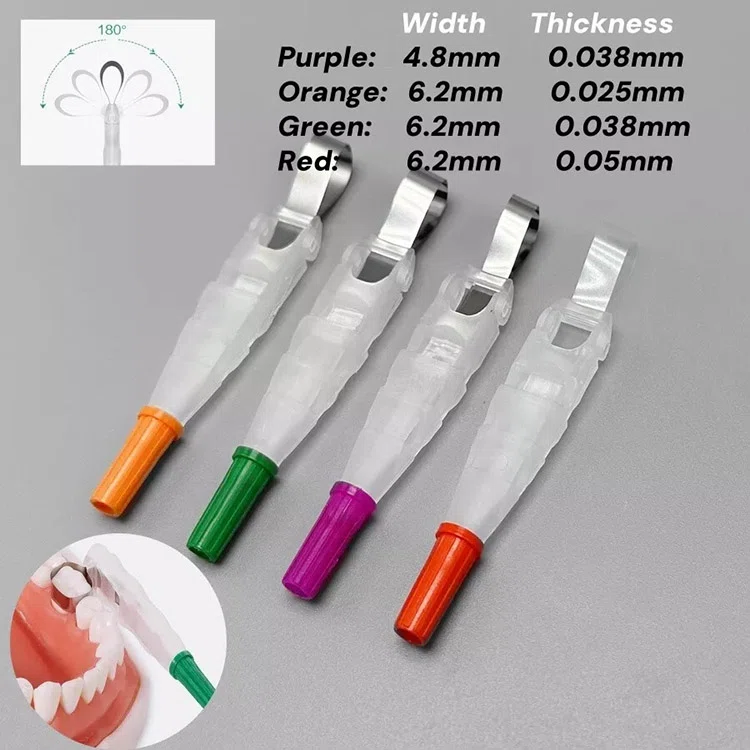
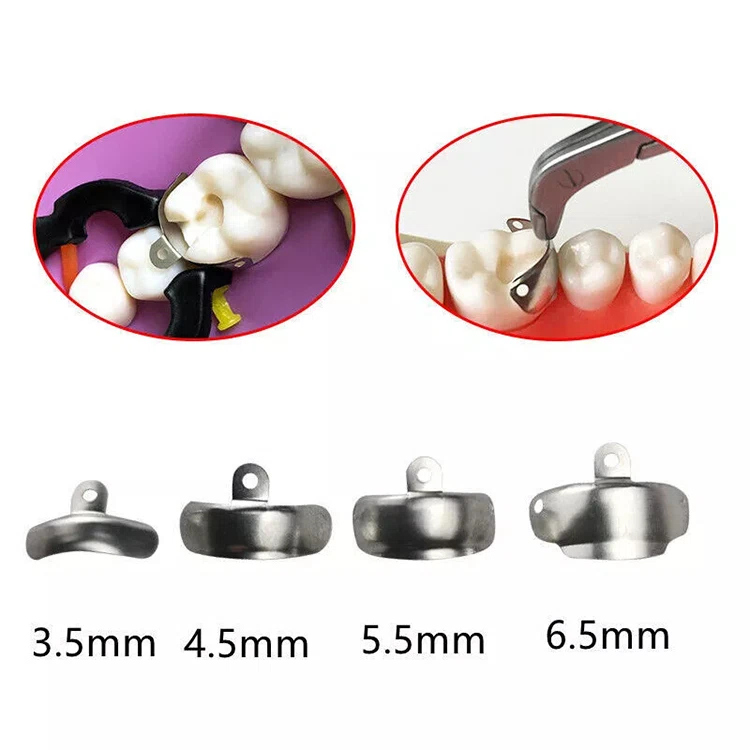
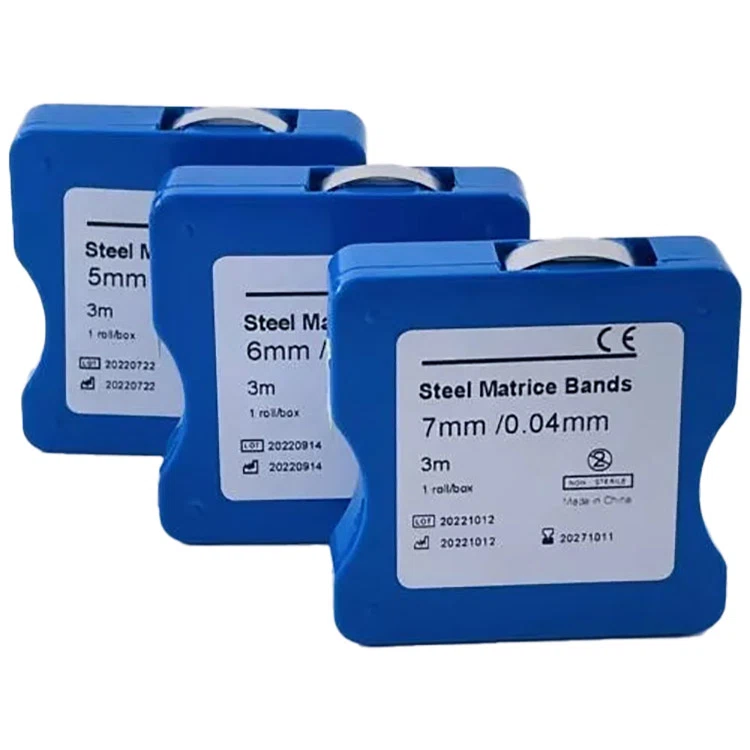
Dental Matrix Bands
- يضمن MatiRial المعزز الخاص القوة والمرونة المناسبة
- مرونة جيدة ومتانة, قوة التقدم جيدة, الثبات بعد الاستخدام المتكرر
- يمكن أن ينحني الانحناء الأكبر ويتناسب مع الأسنان بشكل أكبر
- مادة الراتنج لها مرونة جيدة ومرونة, لا يشوه
- Autoclavable
أشرطة المصفوفة هي من الفولاذ المقاوم للصدأ أو الأجهزة البلاستيكية الطبية من الدرجة الطبية المستخدمة في ترميم الأسنان وعلاجات تقويم الأسنان. أنها تخلق جدران احتواء مؤقتة حول الأسنان للمساعدة في صب المواد التصالحية أثناء الإجراءات السريرية.
توفر نطاقات المصفوفة حدودًا واضحة حول الأسنان, السماح بملء المواد التصالحية بدقة في المنطقة المحددة, مما يؤدي إلى استعادة شكل أسنان مثالي.
مصفوفة فرق الفئة
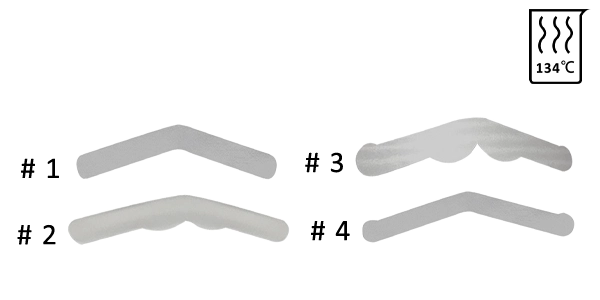
| واسع: #2 سماكة: 0.04مم(0.0015") |
| واسع: #2 سماكة: 0.05مم(0.002") |
| معيار, #1 سماكة: 0.04مم(0.0015") عرض: 6.5مم |
| معيار, #1 سماكة: 0.05مم(0.002") عرض:6.5مم |
| واسع #3 سماكة: 0.04مم(0.0015") |
| واسع #3 سماكة: 0.05مم(0.002") |
| واسع #13 سماكة: 0.04مم(0.0015") |
| واسع #13 سماكة: 0.05مم(0.002") |
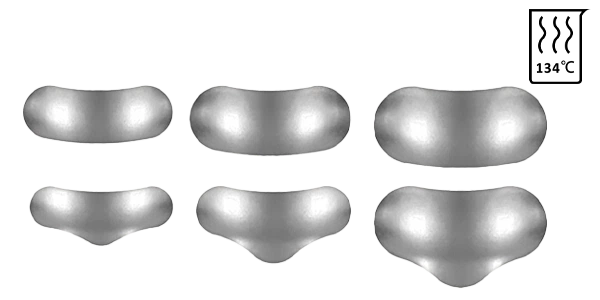
| رقم 1, صعب, premolar, واسع: 4.5مم, سماكة: 0.038مم |
| رقم 2, صعب, المولي, واسع: 5.5مم, سماكة:0.038مم |
| رقم 3, صعب, المولي طويل القامة, واسع: 6.5مم, سماكة: 0.038مم |
| رقم 4, صعب, permolar مع التمديد, واسع: 5مم, سماكة:0.038مم |
| رقم 5, صعب, المولي مع التمديد, واسع: 6.5مم, سماكة:0.038مم |
| رقم 6, صعب, المولي الطويل مع التمديد, واسع: 8.5مم, سماكة: 0.038مم |
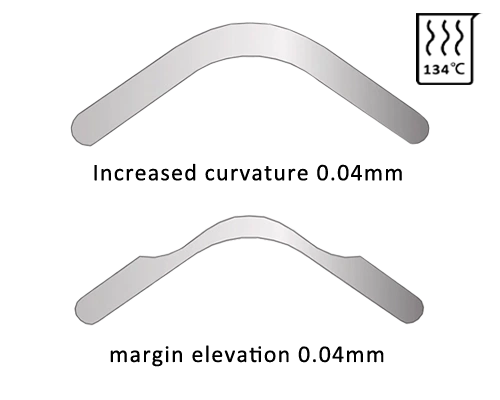
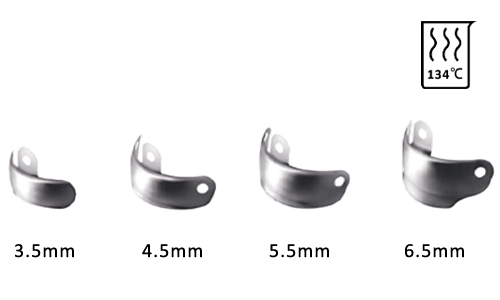
GD-5694 فرق المصفوفة المقطعية
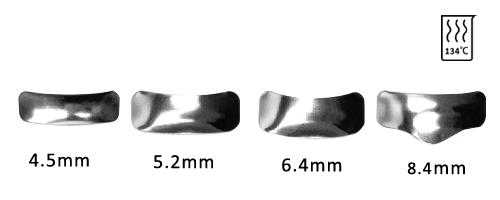
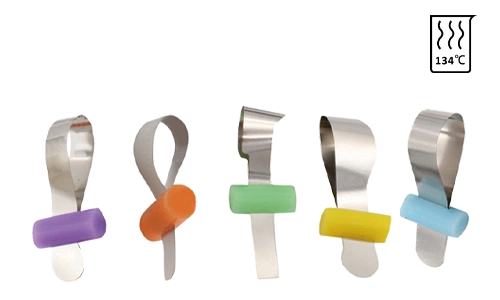
المنتجات التلقائية القابلة للعلاج فقط
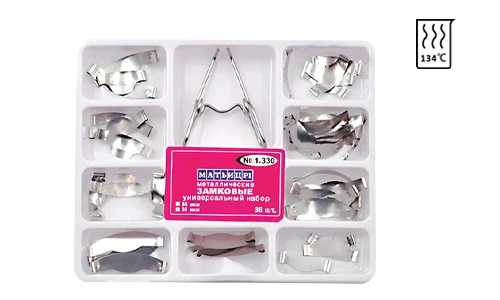
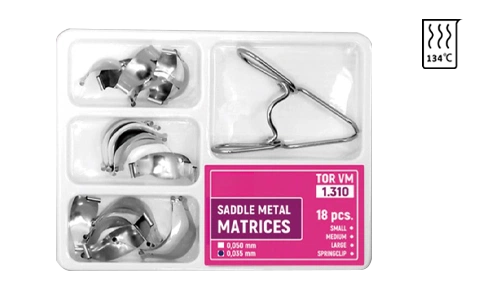
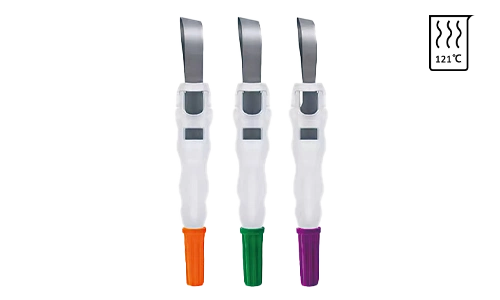
GD-5702 Retainer و Matrix
| الفولاذ المقاوم للصدأ |
| البرتقالي: واسعة 6.2 ملم, سمك 0.025mm, بلا أجنحة أو مع الجناح |
| أخضر: واسعة 6.2 ملم, سمك 0.038mm, بلا أجنحة أو مع الجناح |
| أرجواني: واسعة 4.8 ملم, سمك 0.038mm, بلا أجنحة أو مع الجناح |
| أحمر: واسعة 6.2 ملم, سمك 0.075mm, بلا أجنحة أو مع الجناح, مايلار |
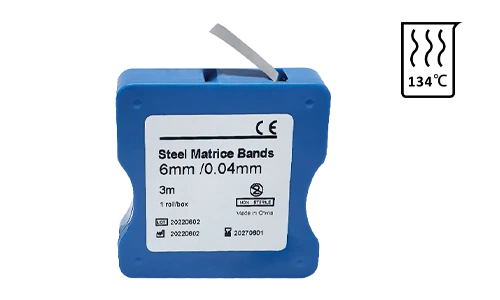
| واسع: 5مم, سماكة: 0.025مم, طول: 3م |
| واسع: 5مم, سماكة: 0.04مم, طول: 3م |
| واسع: 5مم, سماكة: 0.05مم, طول: 3م |
| واسع: 6مم, سماكة: 0.025مم, طول: 3م |
| واسع: 6مم, سماكة: 0.04مم, طول: 3م |
| واسع: 6مم, سماكة: 0.05مم, طول: 3م |
| واسع: 7مم, سماكة: 0.025مم, طول: 3م |
| واسع: 7مم, سماكة: 0.04مم, طول: 3م |
| واسع: 7مم, سماكة: 0.05مم, طول: 3م |
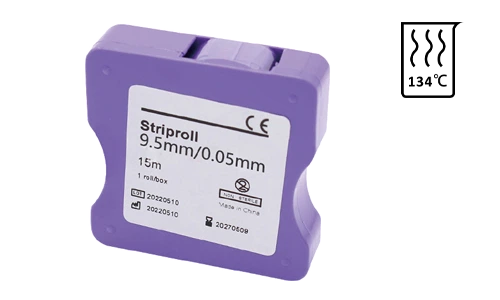
تتوفر نطاقات المصفوفة بأحجام وأشكال مختلفة اعتمادًا على أسنان المريض لاختيارها, مساعدة طبيب الأسنان على السيطرة بدقة على النتيجة التصالحية. يمكن أيضًا استخدام نطاقات المصفوفة بالتزامن مع أسافين الأسنان للتحكم في سمك المادة التصالحية, تجنب مادة التعبئة من أن تكون سميكة جدًا أو رقيقة جدًا.
مع التقدم في التكنولوجيا الطبية, سيصبح تصميم نطاقات المصفوفة أكثر ذكاءً, زيادة الدقة والفعالية في الترميمات. سيؤدي تطور العلوم المادية أيضًا إلى نطاقات مصفوفة مصنوعة من مواد جديدة أكثر راحة ودائمة. مزيد من التفاصيل, الرجاء الاتصال بنا.
The types of dental matrix bands
Sectional Matrix Bands
Sectional matrix bands are most suitable for Class II and Class III cavity restorations, especially posterior teeth. Their pre-designed arcs can well adapt to the anatomical structure of teeth, creating natural proximal contact and preventing protrusion. They are made of thin and tough stainless steel and can maintain stability in narrow Spaces. This is crucial for the bonding of composite materials used in dental fillings.
Circumferential Matrix Bands
Circular (full circle) matrix bands are used for full coverage restoration and can be applied to crown preparation or post-treatment of large Class I cavities. Made of stainless steel or disposable plastic, it offers 360° surround support to ensure even material placement and repair contours.
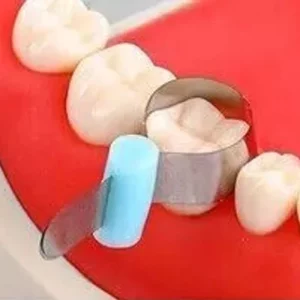
Retainer Matrix Bands
It is often used in situations where the preparation of posterior tooth crowns and large-scale restorations require a relatively long surgical time. It also offers 360° surround support and comes with a built-in locking design, eliminating the need for dental wedges to assist in support. They can provide a long-term state maintenance, waiting for the restoration to complete curing.
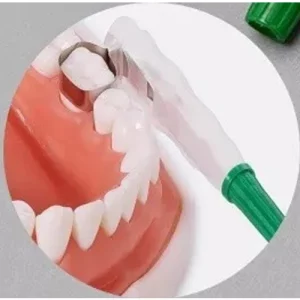
لفة الشريط راتنج
Resin Strip Roll is a kind of matrix band made of plastic, which is cut as much as needed. علاوة على ذلك, resin strip roll is for single use only. There is no need to consider cleaning and disinfecting after use. It is very convenient and saves time.
Why Dentists Trust Our Dental Matrix Bands
- Safe and sterile: Our base tapes all comply with FDA and CE standards. They all undergo strict sterilization before leaving the factory and all support high-temperature and high-pressure sterilization. To prevent cross-infection, it is also recommended that you strictly sterilize before and after each use.
- متانة: The stainless steel matrix band can resist deformation very well during placement and removal, and can still ensure excellent performance after repeated use.
- High precision: Our matrix band undergoes multiple edge pressing processes to ensure fine, smooth and burr-free edges. It can create a tightly sealed environment, prevent the leakage of dental filling materials, and reduce the incidence of postoperative tooth sensitivity and secondary caries.
How to use dental matrix bands correctly
Select the appropriate type and size:
After the examination, based on the X-ray film and the position of the tooth that needs to be filled. Select the type and size of the dental matrix band. If deep caries of the posterior molars need to be filled, it is best to choose Retainer Matrix Bands, which can maintain a stable state for a long time. If it is a wedge-shaped defect of the premolars, Sectional Matrix Bands can be used in combination with interdental wedges to cooperate. This is because the premolars have a good field of vision and the area of the wedge-shaped defect is relatively small, and only part of the tooth body needs to be surrounded.
Safe placement:
When using the matrix band to stabilize the periodontal area, ensure that it is flush with the gum edge and do not apply excessive force to prevent it from embedding into the gum and causing discomfort to the patient.
Check the contour:
Before filling the restorative material, make sure that the contour surrounded by the matrix band is full and natural, and fits well with the tooth. Prevent overfilling or underfilling from hindering subsequent treatment.
Careful removal:
After the repair material has cured, gently remove the matrix band. Then check the edge area to determine the repair effect.
Solve the pain points related to matrix bands
According to the feedback from our customers, there are three major challenges in optimization
1. Difficulty in spatial adaptation:
During the restoration of interproximal caries of molars, the matrix band either cannot fit into the narrow gap or blocks the operational field of vision when inserted.
Optimization Plan: Our GD-5696 Sectional Matrix Bands have been upgraded and differentiated into six models based on the investigation of the molar size and interdental space of thousands of patients. For detailed specifications, please refer to the table above. It basically covers 90% of the patients’ molar samples. Let you no longer have difficulty choosing when doing interproximal molars restoration.
2. Edge leakage issue:
After filling, it is always found that there are flash or even large protrusions at the junction edge, which requires a lot of time for subsequent polishing and grinding. It was caused by the edge of the formed sheet not being sealed well.
Optimization plan: This kind of problem is mostly due to insufficient locking pressure of the forming sheet. أحيانا, when using interdental wedges for assistance, the pressure is uneven, resulting in insufficient edge sealing and overflow of the repair material. The GD-5702 Retainer Matrix Bands we developed later can effectively solve this problem. It can provide 360° surround locking and maintain uniform pressure for a long time.
3. Material durability:
Ordinary stainless steel formed sheets deform after being disinfected three times.
Optimization plan: Upgrade to 316L medical stainless steel material, supporting 134℃ high-pressure steam sterilization, maintaining shape stability after 20 دورات التعقيم.
الأسئلة الشائعة
For anterior tooth restoration, the tooth diameter can be referred to: for central incisors, choose the small type (width 5-6mm), and for canines, choose the standard type (6-7مم). The interproximal Spaces of the posterior teeth need to be measured with periodontal probes
- الفولاذ المقاوم للصدأ (such as GD-5696) : Suitable for the area of the back teeth that bears bite force. A thickness of 0.051mm provides strong support, but it should be noted that the disinfection frequency should not exceed 8 مرات (otherwise, the edge is prone to deformation).
- Memory alloy (GD-5692) : The preferred choice for aesthetic restoration of anterior teeth, it can be bent at 90° and automatically rebound, especially suitable for cases with complex cervical margin curves.
- Common stainless steel: It is recommended to sterilize at 121℃. After more than 10 cycles, the edge sealing force will decrease by 37%, and it needs to be replaced in time.
- Medical-grade 316L stainless steel: Supports rapid sterilization at 134℃ and maintains shape stability after 20 cycles.
Prefer soft and safe types, such as GD-5699 Resin Strip Roll. It is a matrix band made of resin material and the generated pressure is not too intense. It is suitable for patients like children whose teeth are not fully developed.

